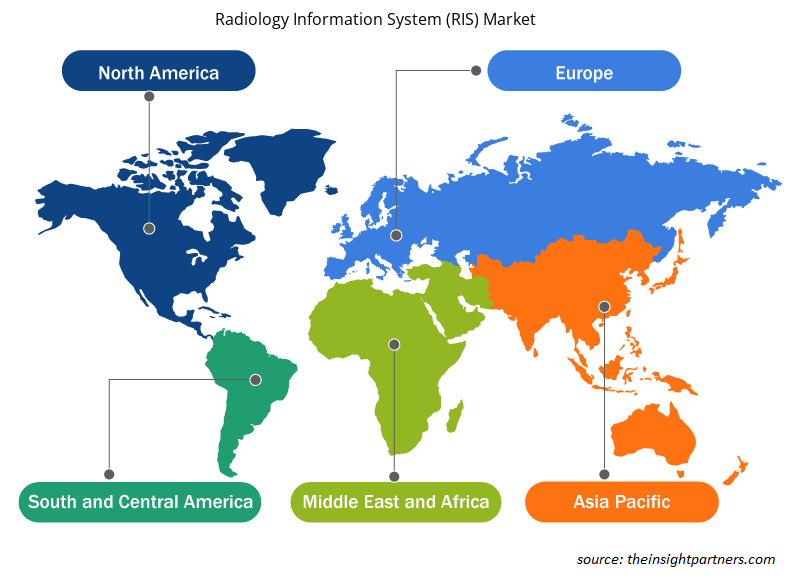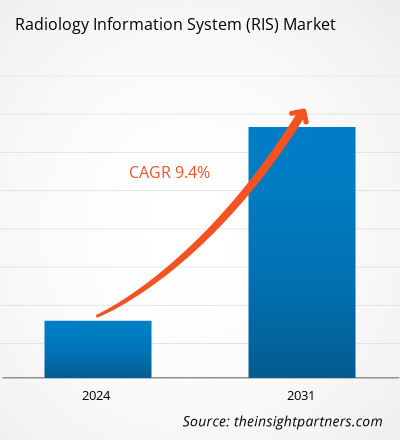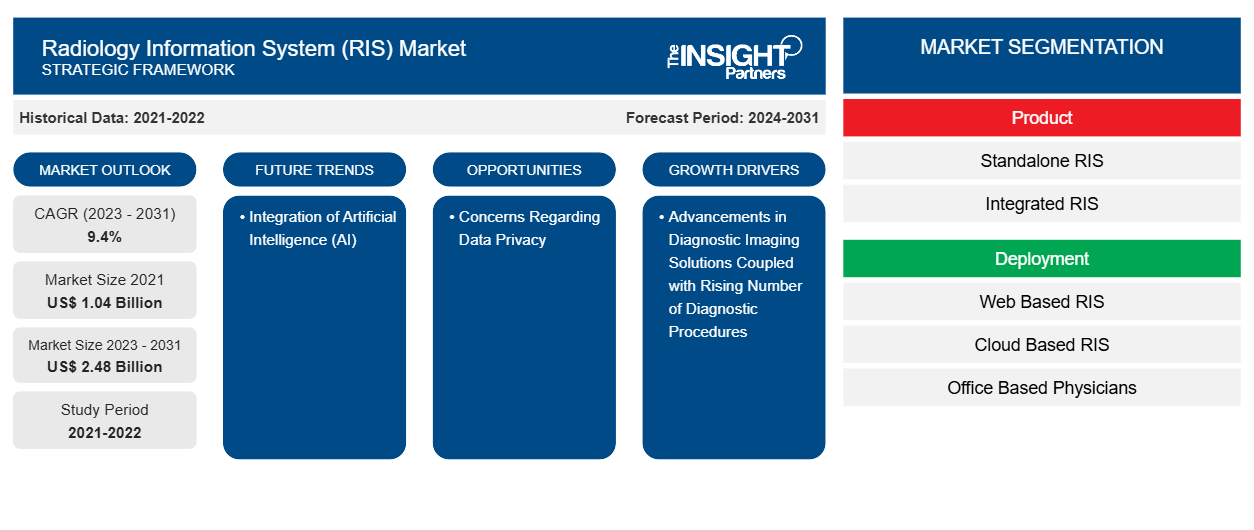El tamaño del mercado de sistemas de información radiológica (RIS) en 2021 se situó en 1.040 millones de dólares estadounidenses y se prevé que alcance los 2.480 millones de dólares estadounidenses en 2031, frente a los XX mil millones de dólares estadounidenses de 2023. Se espera que el mercado registre una CAGR del 9,4% entre 2023 y 2031. Es probable que la creciente concienciación sobre los sistemas de información radiológica (RIS), con sus menores riesgos para la salud y su tasa de adopción en las regiones en desarrollo, siga siendo una tendencia clave en el mercado de los sistemas de información radiológica (RIS).
Análisis del mercado de sistemas de información radiológica (RIS)
Los factores clave para el crecimiento del mercado incluyen el aumento de las tasas de incidencia de enfermedades crónicas, el acceso a los sistemas de tecnología de la información sanitaria y la financiación gubernamental para la investigación del cáncer. Además, la carga de enfermedades crónicas está aumentando en todo el mundo, junto con el creciente envejecimiento de la población, y los trastornos relacionados con el estilo de vida, como el cáncer, la artritis, las enfermedades cardiovasculares y la diabetes, son algunos de los principales factores responsables del crecimiento de este mercado. Se espera que un aumento en los casos de cáncer conduzca a un mayor enfoque en los servicios de radiología para el diagnóstico apropiado, lo que se espera que aumente la demanda de sistemas de información radiológica. El aumento de enfermedades crónicas como el cáncer está impulsando la demanda de sistemas de información radiológica. Sin embargo, se espera que el alto costo de instalación y la falta de mano de obra calificada obstaculicen el crecimiento del mercado durante el período de estudio.
Descripción general del mercado de sistemas de información radiológica (RIS)
RIS es un software sanitario especializado diseñado para gestionar y optimizar las operaciones de los centros de radiología e imágenes. El RIS almacena, gestiona y distribuye imágenes radiológicas , información de los pacientes y datos relacionados. Los avances tecnológicos continuos, incluido el aprendizaje automático, el aprendizaje profundo y la integración de la IA en la atención sanitaria, mejorarán la precisión y la eficiencia de los sistemas de radiología. Además, la creciente demanda de soluciones sanitarias integradas para mejorar la atención al paciente y optimizar los flujos de trabajo está llevando a la adopción de RIS. Las regulaciones e iniciativas gubernamentales también promueven la estandarización de los datos y registros médicos. También proporcionan incentivos para la adopción de servicios de TI de atención sanitaria, que se espera que afecten positivamente a las oportunidades de crecimiento del mercado.
Personalice este informe según sus necesidades
Obtendrá personalización en cualquier informe, sin cargo, incluidas partes de este informe o análisis a nivel de país, paquete de datos de Excel, así como también grandes ofertas y descuentos para empresas emergentes y universidades.
- Obtenga las principales tendencias clave del mercado de este informe.Esta muestra GRATUITA incluirá análisis de datos, desde tendencias del mercado hasta estimaciones y pronósticos.
Impulsores y oportunidades del mercado de los sistemas de información radiológica (RIS)
Avances en soluciones de diagnóstico por imágenes favorecen al mercado
La introducción de la imagen digital ha transformado el campo de la radiología. Catalizó la transición de la imagenología tradicional basada en película a los formatos digitales, optimizó la gestión de datos y aumentó la accesibilidad. El procesamiento de imágenes digitales también condujo a mejoras significativas en la calidad de la imagen. RIS permite al personal de atención médica programar citas para personas tanto en régimen de hospitalización como de consulta externa. La radiología ha avanzado hacia la gestión informatizada en el servicio de salud y ha respondido a la demanda de una comunicación rentable y rápida entre los departamentos de radiología y sus usuarios. En los últimos años, ha habido varios desarrollos en las modalidades de imagenología dentro de la atención médica con fines de diagnóstico. En los últimos años, se han realizado muchos avances en la radiografía digital , incluida la interpretación de rayos X asistida por IA, la imagenología de energía dual, la tomosíntesis, el diagnóstico asistido por computadora, la unión automática de imágenes y la radiografía móvil digital. Estos avances han dado como resultado una mejor calidad de la imagen, lo que ayuda a mejorar la atención al paciente y lograr mejores resultados para el paciente. Además, el uso de la radiografía digital reduce la necesidad de repetir la toma de imágenes, lo que tiene la ventaja de una menor exposición a la radiación.
La creciente adopción de servicios de TI para el sector sanitario en las economías emergentes: una oportunidad para el crecimiento del mercado de los sistemas de información radiológica (RIS)
A nivel mundial, existe una creciente necesidad de adopción de tecnología en los servicios de radiología para satisfacer las demandas. El futuro de los RIS radica en el uso de la inteligencia artificial (IA) y el aprendizaje automático (ML). Los algoritmos de IA pueden ayudar a los radiólogos a analizar imágenes, detectar anomalías y respaldar las decisiones. Los algoritmos de ML pueden aprender continuamente de cantidades masivas de datos y refinar los diagnósticos y los planes de tratamiento. La conectividad mejorada a través de Internet y la tecnología móvil, la teleradiología, la inteligencia artificial, los avances en la informática de imágenes médicas y los dispositivos de imágenes médicas portátiles o móviles pueden permitir que las ubicaciones remotas en cualquier país accedan a una mejor atención médica y diagnósticos. Además, en los países en desarrollo, los sistemas de salud se están volviendo más amigables con la tecnología a medida que los países experimentan una internacionalización de la atención como marcas establecidas. Por ejemplo, la Clínica Cleveland con sede en EE. UU. expandió sus mercados en los Emiratos Árabes Unidos, y la empresa emergente con sede en Inglaterra Babylon, una aplicación de diagnóstico de atención primaria impulsada por el aprendizaje automático y la IA, ingresó a China y Ruanda.
Análisis de segmentación del informe de mercado del sistema de información radiológica (RIS)
Los segmentos clave que contribuyeron a la derivación del análisis del mercado del sistema de información radiológica (RIS) son el producto, la implementación, el componente y el usuario final.
- Según el producto, el mercado de sistemas de información radiológica (RIS) se divide en RIS independientes y RIS integrados. En 2023, el segmento RIS integrado tuvo la mayor participación del mercado y se prevé que el mismo segmento registre la CAGR más alta durante el período de pronóstico.
- Por implementación, el mercado se segmenta en RIS basado en la web, RIS basado en la nube y RIS local. En 2023, el segmento RIS basado en la web tuvo la mayor participación del mercado. Sin embargo, se prevé que el segmento RIS basado en la nube registre la CAGR más alta durante 2023-2031.
- Según los componentes, el mercado de sistemas de información radiológica (RIS) se clasifica en hardware, software y servicios. En 2023, el segmento de servicios tuvo la mayor participación del mercado y se prevé que el segmento de software registre la CAGR más alta durante el período de pronóstico.
- En términos de usuario final, el mercado está segmentado en médicos de consultorio, hospitales y proveedores de servicios de salud de emergencia. En 2023, el segmento de hospitales tuvo la mayor participación del mercado y se estima que el mismo segmento registrará la CAGR más alta durante el período de pronóstico.
Análisis de la cuota de mercado de los sistemas de información radiológica (RIS) por geografía
El alcance geográfico del informe de mercado del sistema de información radiológica (RIS) se divide principalmente en cinco regiones: América del Norte, Asia Pacífico, Europa, Medio Oriente y África, y América del Sur/América del Sur y Central.
América del Norte ha dominado el mercado de sistemas de información radiológica (RIS). Se espera que la demanda del mercado en la región observe un crecimiento a un ritmo significativo debido a varios factores, como la inversión gubernamental en infraestructura de atención médica, la creciente conciencia sobre las imágenes médicas, así como los beneficios asociados con la implementación de RIS. En los EE. UU., factores como la gran cantidad de centros de imágenes en esta región, el rápido ritmo de los avances tecnológicos, el crecimiento de la población geriátrica y la creciente demanda de diagnóstico asistido por computadora, son algunos de los impulsores clave del crecimiento de este mercado. Además, se espera que la presencia de varias empresas dedicadas al desarrollo de sistemas avanzados de RIS para imágenes de diagnóstico cardiovascular, ortopédico, dental y oncológico ofrezca oportunidades de crecimiento para el crecimiento del mercado. Sin embargo, se prevé que Asia Pacífico crezca con la CAGR más alta en los próximos años debido a factores como el crecimiento de la industria de tecnología de la información de atención médica en esta región debido a la mejora de la infraestructura de atención médica y el aumento en la tasa de adopción de técnicas avanzadas de atención médica por parte de los consumidores.
Perspectivas regionales del mercado de sistemas de información radiológica (RIS)
Los analistas de Insight Partners explicaron en detalle las tendencias y los factores regionales que influyen en el mercado de sistemas de información radiológica (RIS) durante el período de pronóstico. Esta sección también analiza los segmentos y la geografía del mercado de sistemas de información radiológica (RIS) en América del Norte, Europa, Asia Pacífico, Oriente Medio y África, y América del Sur y Central.

- Obtenga datos regionales específicos para el mercado de sistemas de información radiológica (RIS)
Alcance del informe de mercado del sistema de información radiológica (RIS)
| Atributo del informe | Detalles |
|---|---|
| Tamaño del mercado en 2021 | 1.040 millones de dólares estadounidenses |
| Tamaño del mercado en 2031 | US$ 2.48 mil millones |
| CAGR global (2023 - 2031) | 9,4% |
| Datos históricos | 2021-2022 |
| Período de pronóstico | 2024-2031 |
| Segmentos cubiertos | Por producto
|
| Regiones y países cubiertos | América del norte
|
| Líderes del mercado y perfiles de empresas clave |
|
Densidad de actores del mercado de sistemas de información radiológica (RIS): comprensión de su impacto en la dinámica empresarial
El mercado de sistemas de información radiológica (RIS) está creciendo rápidamente, impulsado por la creciente demanda de los usuarios finales debido a factores como la evolución de las preferencias de los consumidores, los avances tecnológicos y una mayor conciencia de los beneficios del producto. A medida que aumenta la demanda, las empresas amplían sus ofertas, innovan para satisfacer las necesidades de los consumidores y aprovechan las tendencias emergentes, lo que impulsa aún más el crecimiento del mercado.
La densidad de actores del mercado se refiere a la distribución de las empresas o firmas que operan dentro de un mercado o industria en particular. Indica cuántos competidores (actores del mercado) están presentes en un espacio de mercado determinado en relación con su tamaño o valor total de mercado.
Las principales empresas que operan en el mercado de sistemas de información radiológica (RIS) son:
- Philips NV, una empresa de telecomunicaciones de renombre mundial.
- Siemens Healthineers AG,
- Bayer AG,
- Corporación Cerner,
- Compañía General Electric,
- CORPORACIÓN McKESSON,
Descargo de responsabilidad : Las empresas enumeradas anteriormente no están clasificadas en ningún orden particular.

- Obtenga una descripción general de los principales actores clave del mercado de sistemas de información radiológica (RIS)
Noticias y desarrollos recientes del mercado de sistemas de información radiológica (RIS)
El mercado de sistemas de información radiológica (RIS) se evalúa mediante la recopilación de datos cualitativos y cuantitativos posteriores a la investigación primaria y secundaria, que incluye publicaciones corporativas importantes, datos de asociaciones y bases de datos. A continuación, se incluye una lista de los avances en el mercado de sistemas de información radiológica (RIS):
- Royal Solutions Group, un proveedor líder de software para el cuidado de la salud, se complace en anunciar la expansión de su asociación con Concord Technologies. La integración de tecnología adicional de la suite Practical AI de Concord de soluciones de procesamiento de datos de vanguardia permite escanear fácilmente notas escritas a mano y mecanografiadas, y luego extraer los datos e integrarlos en los flujos de trabajo. Esto promete transformar la forma en que las prácticas médicas manejan la entrada de pedidos, la indexación y la autorización previa. Al automatizar estos procesos críticos, los profesionales de la salud pueden centrarse en la atención al paciente en lugar de en el papeleo. (Royal Solutions Group, LLC, comunicado de prensa, 2024)
- Manipal Hospitals, uno de los principales proveedores de atención médica de la India, ha firmado un acuerdo con FUJIFILM India. En virtud del acuerdo a largo plazo, Manipal Hospitals recibirá un sistema de archivo y comunicación de imágenes (PACS) a gran escala, impulsado por FUJIFILM India. El PACS elimina la necesidad de almacenar, recuperar y enviar manualmente información confidencial, películas e informes. (FUJIFILM India Private Limited, News, 2023)
- PARATUS adquiere una participación mayoritaria en IMAGE Information Systems. IMAGE es un proveedor líder de PACS que presta servicios a centros de diagnóstico por imagen y hospitales de todo el mundo. Esta inversión de PARATUS es un elemento estratégico para establecer un proveedor líder mundial de software y servicios de TI para el sector sanitario. (RADiQ IMAGE Information Systems, News, 2023)
- Philips presenta nuevas soluciones informáticas mejoradas con inteligencia artificial para aumentar la confianza en el diagnóstico con inteligencia en cada paso del flujo de trabajo de radiología en la RSNA. (Koninklijke Philips NV, News, 2022)
Informe de mercado sobre sistemas de información radiológica (RIS) y resultados finales
El informe “Tamaño y pronóstico del mercado de sistemas de información radiológica (RIS) (2021-2031)” proporciona un análisis detallado del mercado que cubre las siguientes áreas:
- Tamaño del mercado y pronóstico a nivel global, regional y nacional para todos los segmentos clave del mercado cubiertos bajo el alcance
- Dinámica del mercado, como impulsores, restricciones y oportunidades clave
- Principales tendencias futuras
- Análisis detallado de las cinco fuerzas de Porter y PEST y FODA
- Análisis del mercado global y regional que cubre las tendencias clave del mercado, los principales actores, las regulaciones y los desarrollos recientes del mercado.
- Análisis del panorama de la industria y de la competencia que abarca la concentración del mercado, el análisis de mapas de calor, los actores destacados y los desarrollos recientes
- Perfiles detallados de empresas
- Análisis histórico (2 años), año base, pronóstico (7 años) con CAGR
- Análisis PEST y FODA
- Tamaño del mercado, valor/volumen: global, regional y nacional
- Industria y panorama competitivo
- Conjunto de datos de Excel
Informes recientes
Testimonios
Razón para comprar
- Toma de decisiones informada
- Comprensión de la dinámica del mercado
- Análisis competitivo
- Información sobre clientes
- Pronósticos del mercado
- Mitigación de riesgos
- Planificación estratégica
- Justificación de la inversión
- Identificación de mercados emergentes
- Mejora de las estrategias de marketing
- Impulso de la eficiencia operativa
- Alineación con las tendencias regulatorias





















 Obtenga una muestra gratuita para - Mercado de sistemas de información radiológica (RIS)
Obtenga una muestra gratuita para - Mercado de sistemas de información radiológica (RIS)